Join this immersive culinary experience, A Hands-on Introduction to Laotian Cuisine, and be transported to the vibrant flavors and traditional cooking techniques of Laos.
Led by an English-speaking guide, this full-day tour takes you on a journey through the rich food culture of Luang Prabang.
Discover the secrets of Laotian cuisine at the Bamboo Tree Restaurant and Cooking School, where you’ll cook authentic dishes and enjoy a complimentary lunch.
Whether you’re a food enthusiast or simply curious, this tour promises a memorable culinary adventure.
Quick Takeaways
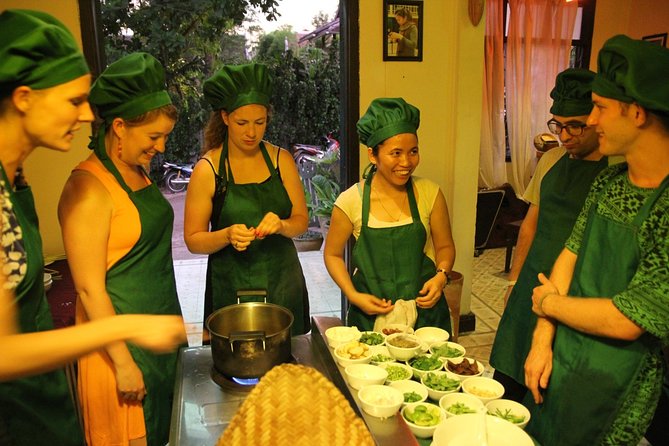
- Laotian cuisine is an essential part of the country’s culinary heritage, known for its unique food traditions and use of Laotian spices.
- Sticky rice is a staple in Laotian cuisine and is enjoyed with almost every meal.
- Traditional ingredients in Laotian cuisine include galangal, lemongrass, fish sauce, and kaffir lime leaves, which add aroma and flavor to dishes.
- Laotian cuisine exhibits regional variations, with Northern Laos known for its spicy dips and grilled meats, and Southern Laos showcasing fish dishes and the use of fresh herbs and vegetables.
Traditional Laotian Dishes
Traditional Laotian dishes are an essential part of the culinary heritage of Laos. With their unique food traditions and the use of popular Laotian spices, these dishes offer a tantalizing blend of flavors and aromas.
One popular spice is padaek, a fermented fish sauce that adds a savory depth to many dishes. Another key ingredient is galangal, a ginger-like root that imparts a citrusy, peppery taste.
Traditional Laotian dishes often incorporate sticky rice, which is a staple in the country and is enjoyed with almost every meal.
From the famous tam mak hoong, a spicy green papaya salad, to the aromatic and flavorful laap, a minced meat salad, these dishes showcase the rich and diverse culinary heritage of Laos.
More tours and activities we've covered in Luang Prabang
Popular Ingredients in Laotian Cuisine
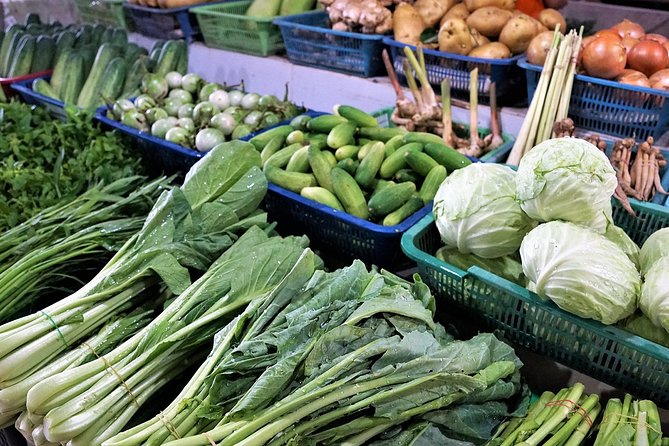
Laotian cuisine incorporates a variety of popular ingredients that contribute to its distinct flavors and culinary traditions. The fusion of flavors in Laotian dishes is a result of the country’s rich cultural history and its proximity to neighboring countries like Thailand, Vietnam, and China. Some of the popular ingredients used in Laotian cuisine include:
| Ingredients | Description | Usage |
|---|---|---|
| Sticky Rice | Glutinous rice | Staple food in Laos |
| Galangal | Ginger-like root | Adds aroma and flavor |
| Lemongrass | Citrusy herb | Enhances soups and curries |
| Fish Sauce | Fermented fish paste | Adds umami flavor |
| Kaffir Lime Leaves | Fragrant leaves | Used in curries and salads |
These ingredients, along with a variety of herbs, spices, and vegetables, create the unique and vibrant flavors that are characteristic of Laotian cuisine. Whether it’s a spicy papaya salad or a comforting bowl of Khao Piak Sen (rice noodle soup), Laotian culinary traditions continue to delight foodies around the world.
Regional Variations of Laotian Food
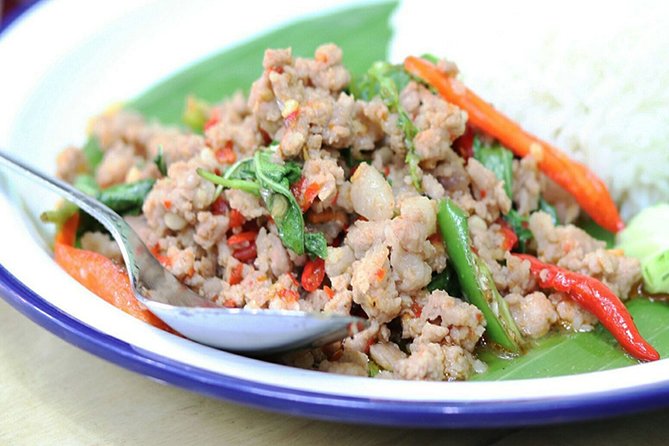
One can find a wide range of regional variations in the cuisine of Laos. Laotian food draws influences from neighboring countries such as Thailand, Vietnam, and China, resulting in a delicious fusion of flavors.
Here are two sub-lists that highlight the regional variations in Laotian food:
Northern Laos:
- Sticky rice is a staple in this region, often served with spicy dips and grilled meats.
- Dishes like laap (a minced meat salad) and khao soi (a rich noodle soup) are popular in the north.
Southern Laos:
- Fish plays a prominent role in the cuisine of the south, with dishes like mok pa (steamed fish wrapped in banana leaves) being a specialty.
- The use of fresh herbs and vegetables, such as lemongrass and basil, is more prevalent in southern dishes.
These regional variations showcase the diversity and richness of Laotian cuisine, making it a culinary adventure worth exploring.
Essential Cooking Techniques in Laotian Cuisine
The regional variations in Laotian cuisine offer a wide array of cooking techniques that are essential to creating the diverse and flavorful dishes found throughout the country. Laotian cooking methods are deeply rooted in tradition and reflect the country’s rich culinary heritage. From stir-frying to grilling, each technique brings out unique flavors and textures in the dishes. Here is a table highlighting some essential cooking techniques in Laotian cuisine:
| Cooking Technique | Description |
|---|---|
| Stir-frying | Quick cooking method that involves tossing ingredients in a hot pan with oil and high heat. It preserves the freshness and crunchiness of vegetables and meats. |
| Grilling | A popular method of cooking meats, fish, and vegetables over an open flame. It imparts a smoky flavor and beautiful char marks. |
| Steaming | Delicate ingredients like dumplings and fish are cooked by steam. This method retains the natural flavors and nutrients of the food. |
| Boiling | Used for soups, broths, and stews, boiling involves cooking ingredients in a liquid until they are tender and flavors are infused. |
These Laotian culinary traditions contribute to the vibrant and diverse food culture of Laos. By mastering these cooking techniques, one can create authentic Laotian dishes that capture the essence of the country’s cuisine.
Must-Try Street Food in Laos
When exploring the vibrant culinary scene in Laos, travelers are encouraged to indulge in the must-try street food offerings. The streets of Laos are a treasure trove of flavors, aromas, and textures, showcasing the rich culinary heritage of the country.
Here are some street food recommendations that shouldn’t be missed:
Khao Jee Sandwiches: These delicious baguette sandwiches are a popular street food choice in Laos. Filled with a variety of ingredients such as grilled meat, pate, fresh herbs, and pickled vegetables, they offer a delightful mix of flavors and textures.
Larb: A famous Laotian dish, larb is a savory salad made with minced meat (usually chicken or pork), mixed with herbs, lime juice, fish sauce, and toasted rice powder. It’s bursting with bold flavors and is often served with sticky rice.
Indulging in these street food delights will give travelers a true taste of Laotian cuisine and its unique flavors.
- Luang Prabang: UNESCO World Heritage City Highlights Tour
- From Luang Prabang: Thin Pha Trail & Tad Sae Falls Trek
- Kuang Si Waterfalls by Bike and Boat
- Luang Prabang Evening Food Tour by Tuk-Tuk
- Luang Prabang: Mountain Trek & Local Villages Overnight Tour
- Ban Chanh Pottery Making Workshop in Luang Prabang
Laotian Desserts and Sweet Treats
Travelers exploring the vibrant culinary scene in Laos will be delighted to discover a variety of delectable Laotian desserts and sweet treats. Laotian dessert recipes are known for their unique flavors and use of local ingredients.
One popular sweet treat is Khao Tom, a sticky rice dessert filled with coconut, sugar, and black beans, wrapped in a banana leaf and steamed until it becomes soft and gooey.
Another must-try is Khanom Krok, which are small coconut pancakes cooked in a special griddle, resulting in a crispy exterior and a soft, custard-like center.
For those with a sweet tooth, look out for Sangkhaya, a coconut custard served with bread or sticky rice.
These Laotian desserts offer a delightful end to any meal, showcasing the rich and diverse flavors of Laos.
Exploring Laotian Food Culture and Customs
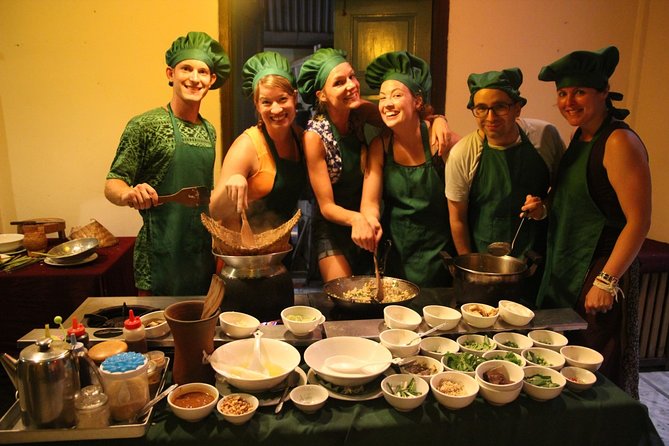
Laotian food culture and customs reveal a fascinating array of culinary traditions and practices. These traditions are deeply rooted in the country’s history and have been shaped by various cultural influences.
Here are some key aspects of Laotian food traditions and the cultural influences on Laotian cuisine:
Staple Foods:
Sticky Rice: Known as ‘khao niao,’ sticky rice is a staple in Laotian cuisine. It’s traditionally eaten with one’s hands and accompanies almost every meal.
Fresh Herbs and Vegetables: Laotian dishes are often abundant in fresh herbs and vegetables, such as lemongrass, cilantro, mint, and lime leaves. These ingredients add vibrant flavors and freshness to the dishes.
Cultural Influences:
Neighboring Countries: Laotian cuisine has been influenced by the culinary traditions of its neighboring countries, including Thailand, Vietnam, and China. This is evident in the use of spices, techniques, and ingredients in Laotian dishes.
French Influence: During the French colonial period, French culinary techniques and ingredients were introduced to Laos. This influence can be seen in certain dishes like baguettes and French-inspired pastries.
Laotian food traditions and the cultural influences on Laotian cuisine create a unique and flavorful culinary experience that’s a reflection of the country’s rich history and diverse cultural heritage.
Common Questions
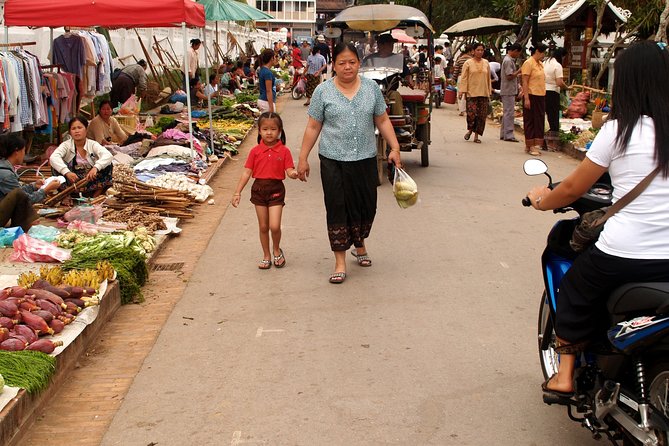
What Is the Cost of the Full Day Tour With the Cooking Class Included?
The cost of the full day tour with the cooking class included varies depending on dietary restrictions. It covers a professional English-speaking guide, tuk tuk transfers, use of a cooking station with all utensils and ingredients, and lunch at the cooking school.
Are There Any Dietary Restrictions or Preferences That Can Be Accommodated During the Cooking Class?
The cooking class can accommodate dietary restrictions and offers vegetarian options. Participants can inform the English-speaking local chefs about their specific needs, ensuring a personalized and inclusive experience in discovering Laotian cuisine.
Can Children Participate in the Cooking Class?
Children of all ages can participate in the cooking class. There are no age restrictions, but parental supervision is required. This hands-on experience not only teaches culinary skills but also provides educational benefits.
Is Transportation Provided From Hotels Located Outside of the Central Area of Luang Prabang?
Transportation options are available for hotels outside of central Luang Prabang. Guests can enjoy a full day tour with a professional English-speaking guide and joint tuk tuk transfers with a professional driver.
How Many People Will Be in the Cooking Class at Once?
The cooking class capacity at the Bamboo Tree Restaurant and Cooking School is designed to accommodate a small group size. Guests can expect an engaging and informative experience while learning the secrets of Laotian cuisine.
The Sum Up
To sum it up, A Hands-on Introduction to Laotian Cuisine offers a unique and immersive culinary experience in Luang Prabang. Participants have the opportunity to learn from local chefs, cook their own authentic Laotian dishes, and enjoy a complimentary lunch.
Whether you’re a food enthusiast or simply curious about Laotian cuisine, this tour provides a memorable adventure through the vibrant flavors and traditional cooking techniques of Laos.
Don’t miss the chance to explore the rich food culture and customs of this beautiful country.
More Workshop Tours in Luang Prabang
More Tour Reviews in Luang Prabang
- Chiang Rai: 3days 2nights Trip Slow Boat to Luang Prabang
- From Chiang Mai : 3 Day 2 Night Slow Boat to Luang Prabang
- From Chiang Mai: Luang Prabang 3-Day 2-Night Slow Boat Tour
- Chiang Mai to Luang Prabang: by Slow Boat 3 Days 2 Nights
- From Chiang Rai Slow Boat to Luang Prabang 3 Days 2 Night
- From Chiang Rai: 2-Day Slow Boat to Luang Prabang
Looking for something different? Other Luang Prabang activities we've written about
- Chiang Rai: 3days 2nights Trip Slow Boat to Luang Prabang
- From Chiang Mai : 3 Day 2 Night Slow Boat to Luang Prabang
- 14 Best Workshops And Classes In Luang Prabang
- 13 Best Shopping Tours In Luang Prabang
- 25 Best Tours In Luang Prabang
- 3 Best 3 Day Tours In Luang Prabang
- Best 2 Day Tours In Luang Prabang
- 15 Best Boat Tours And Cruises In Luang Prabang
- 15 Best Full-Day Tours In Luang Prabang
- 4 Best Private Driver Services In Luang Prabang
- 2 Best Guided Tours In Luang Prabang
- 2 Best Guided Tours In Luang Prabang
